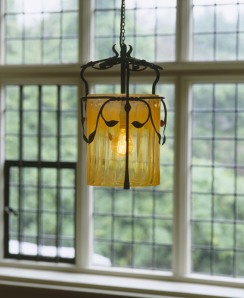Recently, I spoke to a visitor who said that he’d never visited Standen before, but was a little short of time – were there any objects that he simply shouldn’t miss? This was a tricky question, because although Standen is modest when compared to some country houses, there’s still much to see.
I told the visitor a few objects to look out for, but mostly advised him to ask the room guides as he went around. But it got me thinking – if I’d had more time to prepare, what would I suggest someone on a flying visit to the house absolutely shouldn’t miss?
Thinking about the objects and features that are most remarked on by visitors to the house – and only a little influenced by my own opinions – I chose 6 ‘must-see’ objects. In no particular order, here they are…
 Dobbin
Dobbin
Dobbin is the well-loved rocking horse that resides in the Billiard Room. He was brought for Amy Beale, the eldest of the James and Margaret Beale’s children in 1874, when she was 3 years old. Family anecdotes indicate that Dobbin was a reward for Amy learning the alphabet! Dobbin is a lovely, direct link to the Beales, and visitors always stop and admire him.
Dining Room fireplace surround
The fireplace is one of the most striking features of the Dining Room and is frequently commented upon by visitors. The fireplace surround was designed by Standen’s architect, Philip Webb, and made by John Pearson. The metalworking technique used to create the decoration is called repoussé, and the material used is mild steel. The rack above the fireplace could be used by servants to rest plates and platters when serving the family at mealtimes – this is an instance of Webb and his thorough design process; where he tailored his designs to the lifestyle of his clients.
 Silver pip trays
Silver pip trays
Another must-see object in the Dining Room, is one that is almost always commented upon by visitors. These clever silver trays attach on to the edge of plates, and were used to deposit unwanted pips and seeds throughout the course of a meal. The Dining Room table is currently presented as the dessert course of an evening meal, with bowls of fruit and the pip trays attached to the dessert plates. Visitors always ask what the trays are for, and I like to give them a clue by pointing out the fruit on the table.
 Benson light fittings/lamps
Benson light fittings/lamps
This is cheating slightly, as this isn’t one specific object, but a type of object. The light fittings throughout the house were designed by W.A.S Benson, a friend and colleague of William Morris. He was a talented designer who owned a workshop and also designed for – and was later a director of – Morris & Co. Benson was well known for interpreting the requirements of lighting in an inventive and technically ingenious way, such as lamps which adapted to hang on walls or sit on tables. His creativity can be seen throughout Standen, and I especially like the beautiful hanging lights, like the one pictured, on the half landing.
 Acanthus bedspread
Acanthus bedspread
This Morris & Co. bedspread is displayed in the Westbourne bedroom. It was given to Standen to display after spending a hundred years in storage. Its time in storage means that the bedspread is in excellent condition, and the colours of the design are particularly vivid. The bedspread was handmade at the Morris & Co. factory, and it is possible that William’s daughter, May, who was famed for her embroidery skills, supervised the work on this bedspread.
Clavichord*
The clavichord is on long term loan and is displayed in the Morning Room. It was made by Dolmetsch in 1897, and is beautifully decorated by Edward Burne-Jones, who was closely associated with the Pre-Raphelite movement. The clavichord has been conserved and is playable, but special training is needed, as it doesn’t play like a piano. We have a volunteer that plays the clavichord occasionally, and visitors are always fascinated by the sound it makes.
*There’s no image for the clavichord: because the object is on loan to Standen, we are not able to publish images of it without the permisson of the owner – but that’s the perfect excuse for you to come and visit us, and see it ‘in the flesh’!
What are your must-see objects at Standen?
